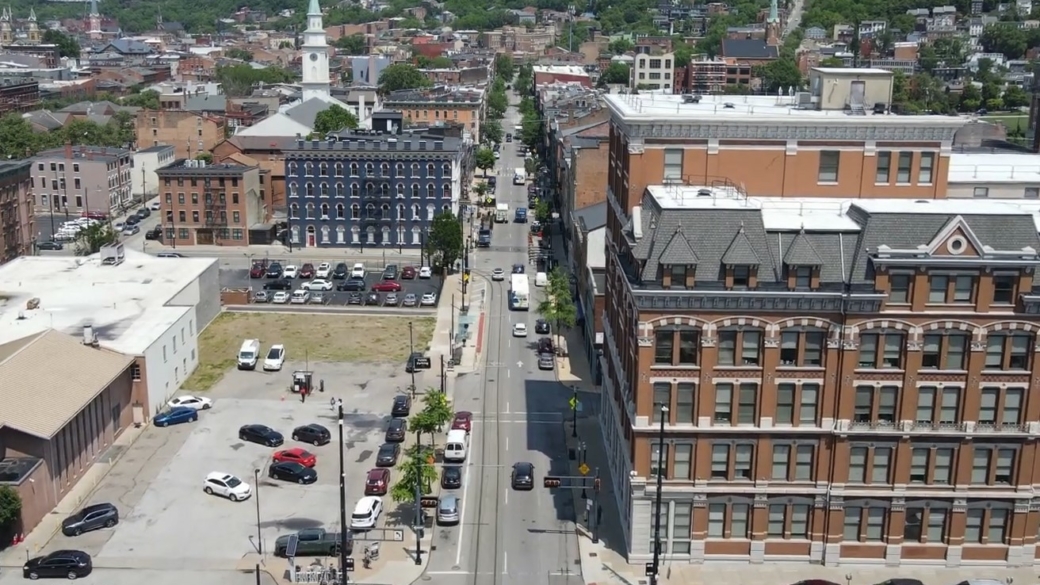Reasons Not to Move to Cincinnati
Cincinnati, often affectionately labeled as the Queen City of the West, boasts a storied past and a lively cultural scene. Nevertheless, it’s prudent to consider the drawbacks before making the decision to relocate to this city.
In the following discussion, we’ll delve into 20 reasons not to move to Cincinnati. We’ll commence with the 20th reason and progressively uncover the most pressing concerns, culminating with the top-ranked issue at number 1.
20. Limited Public Transportation Options
First on the list of the reasons not to move to Cincinnati is the limited public transportation options. Cincinnati faces notable limitations in its public transportation system, predominantly relying on the Metro bus service.
Regrettably, the Metro service has faced criticism for its unreliability and limited coverage. Consequently, many residents heavily depend on personal vehicles, resulting not only in increased traffic congestion but also imposing significant inconveniences on those lacking access to a car. Additionally, the streetcar system, which had the potential to mitigate some of these issues, operates within a highly restricted area, falling short of meeting the broader community’s transportation needs.
This absence of a comprehensive public transit network often translates to residents expending more time and resources on daily commutes, inevitably impacting their overall quality of life.
19. High Sales Tax
The people of Cincinnati must grapple with a sales tax rate that stands at a relatively high 7%. This figure surpasses the national average, resulting in elevated costs for everyday purchases for the city’s residents. Over time, this elevated rate can exert a substantial impact on the financial well-being of families and individuals residing in Cincinnati.
Furthermore, the prospect of this heightened sales tax rate may deter new businesses from establishing themselves in the city, thereby limiting economic growth and development within the region. Individuals considering a move to Cincinnati should thoroughly assess the long-term financial ramifications associated with this elevated sales tax rate.
18. Allergies and Air Quality
Cincinnati has earned a reputation for its high pollen count, posing particular challenges for individuals who suffer from allergies. Additionally, the city has struggled with air quality issues, frequently issuing smog and pollution alerts. These challenges can be a significant deterrent for those with respiratory conditions or those who prioritize living in areas with pristine, fresh air.
Furthermore, Cincinnati’s location within the Ohio River Valley tends to trap pollutants, exacerbating the city’s air quality concerns. Prospective residents with health considerations related to air quality should conduct thorough research into different neighborhoods and may even consider visiting at various times of the year to personally assess the air quality before reaching a decision.
17. Limited Nightlife Options
While Cincinnati boasts a variety of restaurants and bars, its nightlife scene does have certain limitations compared to other larger U.S. cities. Late-night entertainment options may not offer the same diversity, which could be a drawback for young professionals and individuals who relish vibrant nightlife experiences.
Also, existing nightlife establishments often experience overcrowding, and the entertainment districts can become quite noisy, which may not align with everyone’s preferences. If a lively nightlife ranks high on your list of priorities, you might want to explore other cities known for their more dynamic nighttime economies.
16. Education System Concerns
Cincinnati’s education system has encountered scrutiny due to its lack of consistency. While there are notable schools, many have low test scores and limited resources, presenting an alarming concern for families with school-age children.
The quest for a quality school here can be a challenging endeavor. Furthermore, the city contends with a higher-than-average student-teacher ratio, potentially hampering students’ access to the individualized attention they require for success.
Prospective residents should conduct thorough research on schools in the area to ensure they align with their expectations. But private schooling options might be worth considering, though they come with significant additional expenses.
15. Crime Rates
Cincinnati also has areas with elevated crime rates. While some neighborhoods are known for being safe, others have been considered less secure. It is imperative to conduct thorough research on the safety of various neighborhoods and carefully consider crime statistics when contemplating a move to Cincinnati.
Also, the city has challenges related to gang violence and drug-related crimes, which persist in specific neighborhoods. Prospective residents should remain vigilant about these issues and factor them into their decision-making process when selecting a neighborhood to call home.
14. Limited Job Market
Cincinnati’s job market, like in many cities, can present limitations, particularly within certain industries. While opportunities exist in sectors such as healthcare and education, individuals in other fields might encounter challenges in finding suitable employment within the city.
Furthermore, the average salary in Cincinnati tends to be lower than in comparable cities, potentially dissuading professionals in high-paying industries. It is advisable to secure a job before relocating to ensure a seamless transition and to conduct diligent research into the job market within your specific field to confirm the availability of suitable opportunities.
13. Urban Sprawl
Cincinnati has witnessed a notable expansion of urban sprawl, resulting in traffic congestion and extended commute times. The city’s layout, characterized by numerous suburbs, often entails lengthy drives to work, a drawback for many individuals.
Furthermore, this urban sprawl has contributed to a lack of unity and community cohesion in various areas, with residents feeling somewhat isolated from amenities and services. This circumstance can pose difficulties in cultivating a sense of community and belonging, which holds particular significance for those seeking to establish their lives in a new city.
12. High Property Taxes
Homeowners in Cincinnati face the challenge of managing high property taxes, which can impose a significant financial burden. These elevated rates have the potential to offset the advantages of property ownership in the city, potentially diminishing its appeal for prospective homeowners.
Additionally, the burden of high property taxes may dissuade investment in the city, thereby constraining economic growth and development. Individuals considering home ownership in Cincinnati should give thorough thought to the long-term financial consequences associated with these property tax rates.
11. Weather Extremes
Cincinnati has a diverse spectrum of weather conditions, spanning from hot and humid summers to cold and snowy winters. These extreme weather patterns may deter individuals accustomed to more temperate climates.
Also, this city is prone to thunderstorms and tornadoes, which are dangerous and can lead to significant property damage or, at worst, even death. One must know how to prepare for these kinds of inevitable weather conditions and think about the overall quality of life before moving to this city.
10. Historic Preservation vs. Development Conflicts
While Cincinnati has a rich history, it occasionally clashes with modern development initiatives. This conflict can, at times, impede progress and restrict the availability of contemporary housing and amenities.
Furthermore, historic preservation efforts may, in certain instances, prioritize buildings and monuments over essential community needs, resulting in limited development in areas that require it the most. Prospective residents should be aware of these dynamics and contemplate how they might influence their day-to-day experiences within the city.
9. Limited Green Spaces
While Cincinnati has some parks, it may not have an abundance of green spaces. This could be a drawback for nature enthusiasts and individuals seeking outdoor recreational opportunities.
Furthermore, the existing parks can become quite crowded, particularly on weekends and holidays, making it challenging to find a tranquil space for relaxation and unwinding. Those who prioritize access to green spaces should conduct thorough research on the available options and assess whether they align with their needs before reaching a decision.
If you’re someone that loves scenery and the outdoors, this could be one of the most important reasons not to move to Cincinnati.
8. High Utility Bills
Residents in Cincinnati frequently encounter elevated utility bills, particularly during the extreme weather seasons, thereby causing a financial burden to its residents. The infrastructure in the city also has trouble meeting the demand of the population, causing frequent outages and other issues. In this case, one should expect to pay more than usual for utilities and make sure their budget is ready before making a decision.
7. Parking Issues
Parking in Cincinnati can prove to be a significant challenge, particularly in the downtown area. A scarcity of parking spaces and high fees can lead to daily frustrations for residents. Additionally, the city has encountered problems associated with insufficient parking infrastructure, resulting in congestion and traffic concerns in bustling areas.
Those intending to use a car regularly should conduct thorough research on the parking situation in various neighborhoods to ensure it aligns with their needs before making a decision.
If you cannot live without using your car to get from A to B, this will be one of the most significant reasons not to move to Cincinnati.
6. Overcrowded Tourist Spots
Popular tourist destinations in Cincinnati often experience overcrowding, particularly during peak seasons, which can diminish the enjoyment of residents looking to visit these spots. Moreover, overcrowding can give rise to concerns related to littering and vandalism, potentially detracting from the appeal of these locations.
Prospective residents should take note of these issues and reflect on how they may influence their overall enjoyment of the city’s attractions before finalizing their decision.
5. Sports Team Performance
Cincinnati boasts a rich sports history; however, the performance of its teams has exhibited inconsistency recently, which may disappoint passionate sports enthusiasts. When it comes to the sports venues located here, the area can become very crowded and come with a significant cost that can hinder the overall enjoyment of sports fans.
Those who have an interest in sports should evaluate the performance and accessibility of the venues where they can watch live events before relocating to the city.
4. Lack of Diversity in Some Neighborhoods
Some neighborhoods in Cincinnati may be characterized by a lack of diversity, which could be less appealing for individuals seeking a multicultural environment. Furthermore, this absence of diversity can occasionally result in challenges related to inclusivity and representation, which may pose significant concerns for prospective residents from diverse backgrounds.
It’s vital to thoroughly examine the demographics of various neighborhoods and assess whether they align with your preferences and needs before reaching a decision.
3. Fluctuating Housing Market
Cincinnati’s housing market can be quite volatile, with price changes creating difficulties for potential buyers looking for affordable homes. Furthermore, the city has faced issues related to housing shortages, which can drive up prices and create obstacles for first-time buyers trying to enter the market. Individuals contemplating a move to Cincinnati should be prepared to navigate a housing market that can be unpredictable and conduct extensive research on housing trends before making their final decision.
The fluctuating housing market is 3rd on the list of the biggest reasons not to move to Cincinnati.
2. Infrastructure Issues
Cincinnati confronts infrastructure challenges, encompassing aging roads and bridges that can present commuting difficulties and potentially raise safety concerns. Furthermore, the city has encountered problems with flooding and inadequate drainage systems, which carry safety risks and may result in significant damage. Prospective residents should take note of these infrastructure issues and contemplate how they might influence their daily lives and safety considerations before settling on a decision.
1. Economic Disparities – Biggest Reason Not to Move to Cincinnati
The most prominent reason to think twice about relocating to Cincinnati is the prevalent economic disparities within the city. A significant gap exists between affluent and low-income neighborhoods, giving rise to a host of challenges, including crime, educational disparities, and limited opportunities for upward mobility. This enduring economic divide remains a critical concern that Cincinnati has been grappling with for an extended period.
Furthermore, these disparities can occasionally lead to tensions and conflicts, resulting in an unstable and divided community. It’s essential to thoroughly consider the broader economic landscape and its potential impact on your quality of life before making a decision to move to Cincinnati.
People Also Read
15 Reasons Not to Move to Seattle


